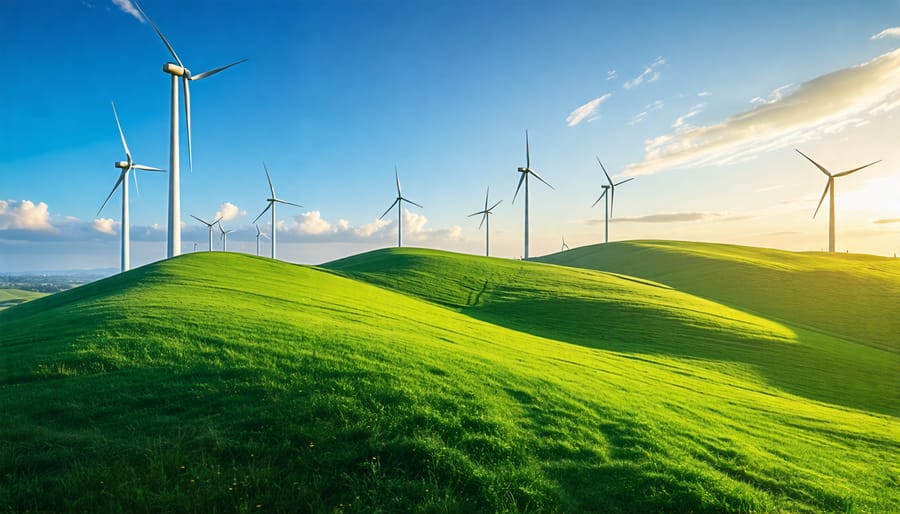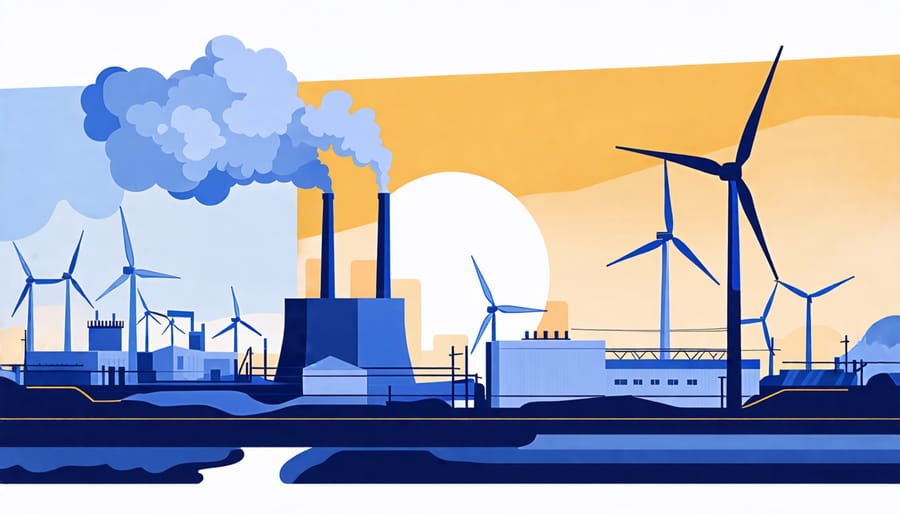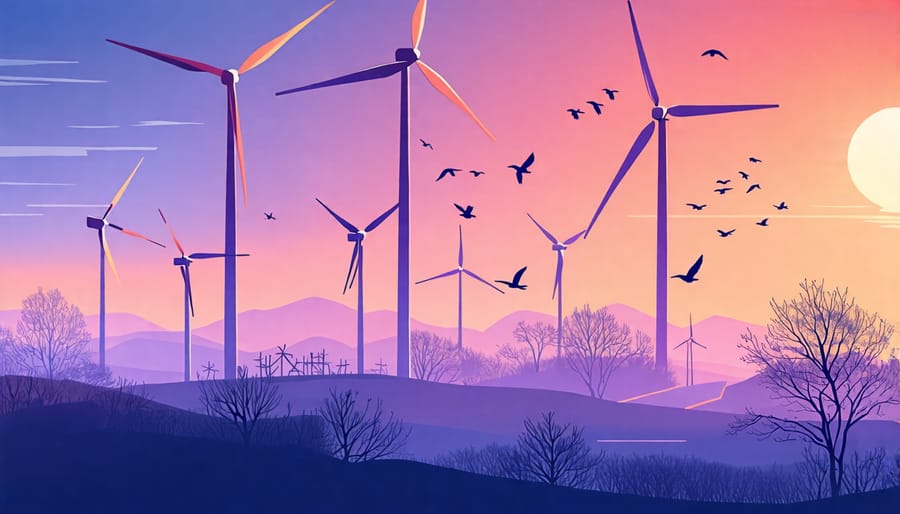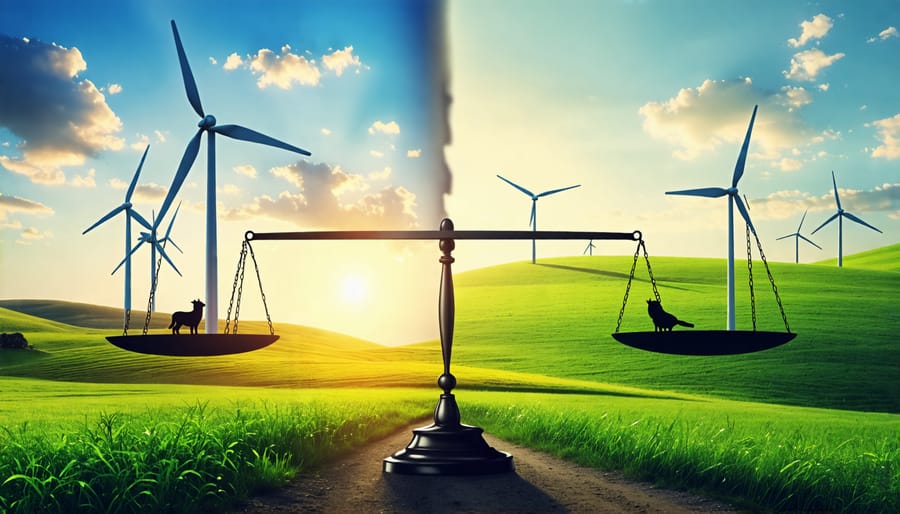Wind energy has emerged as a promising solution to our growing energy needs, but its environmental impact remains a topic of much debate. As countries around the world invest heavily in wind power, it’s crucial that we carefully examine both the benefits and drawbacks of this renewable energy source. This article delves into the complex relationship between wind turbines and the natural world, exploring how they affect everything from wildlife and habitats to global carbon emissions. By understanding the full scope of wind energy’s environmental footprint, we can make informed decisions about its role in building a sustainable future for our planet.
Wind Energy’s Positive Environmental Impacts


Cleaner Air and Lower Carbon Footprint
Wind energy plays a crucial role in improving air quality and mitigating climate change by reducing greenhouse gas emissions and other pollutants associated with fossil fuel-based power generation. By harnessing the power of the wind, turbines generate clean electricity without emitting harmful substances like carbon dioxide, sulfur dioxide, and nitrogen oxides, which contribute to smog, acid rain, and respiratory illnesses. How wind power functions is by converting kinetic energy from the wind into electrical energy, providing a renewable and sustainable alternative to coal, oil, and natural gas.
According to the American Wind Energy Association, wind energy in the United States alone avoided 42 million cars’ worth of CO2 emissions in 2019. As more wind farms are developed and integrated into the power grid, they displace a significant portion of fossil fuel-generated electricity, resulting in cleaner air and a lower carbon footprint. Furthermore, wind energy’s potential to mitigate climate change is immense, as it can help nations meet their targets under the Paris Agreement and reduce the devastating impacts of global warming on ecosystems and communities worldwide. By investing in wind power, we can create a cleaner, healthier environment for present and future generations.
Water Conservation
Wind power offers a significant environmental advantage over many traditional energy sources due to its minimal water usage. While fossil fuel-based power plants and nuclear reactors require vast amounts of water for cooling and steam generation, wind turbines need virtually no water to operate. This makes wind energy an attractive option in regions facing water scarcity or drought conditions. By relying on wind power, communities can conserve precious water resources for essential needs like agriculture, sanitation, and human consumption. Additionally, the lack of water usage in wind power generation helps to prevent water pollution that can occur from the discharge of heated or contaminated water from conventional power plants. As the global demand for clean water continues to rise, the water-saving benefits of wind energy become increasingly valuable in the pursuit of a more sustainable future. Embracing wind power as a primary energy source can play a crucial role in alleviating the strain on our planet’s limited water supply while still meeting our growing energy needs.
Potential Negative Environmental Impacts
Noise Pollution and Visual Impact
While wind turbines generate clean, renewable energy, they can have noise and visual impacts on surrounding communities. Modern wind turbines produce mechanical and aerodynamic sounds, typically around 45 decibels at a distance of 300 meters – about as loud as a refrigerator. However, this noise can be more noticeable in quiet, rural areas and may cause annoyance for nearby residents. Proper siting and setbacks from homes can mitigate these concerns.
Wind farms also alter landscapes, as turbines are tall, visible structures often placed in open, scenic areas. Some people find them visually appealing, seeing them as symbols of clean energy progress. Others view turbines as eyesores that disrupt natural scenery. Visual impacts can be reduced by careful placement that considers topography and by using fewer, larger turbines rather than many small ones.
Research suggests that while a minority of people find wind turbine noise and visual changes highly annoying, most communities adapt over time. Proactive communication, community engagement in planning, and responsible siting that balances energy needs with noise and visual concerns can help maximize wind power’s environmental benefits while minimizing local impacts. As technology advances, even quieter and more efficient turbine designs may further reduce these issues in the future.
Wildlife Collisions
While wind energy is a clean and renewable power source, wind turbines can pose a risk to flying wildlife. Birds and bats may collide with turbine blades, resulting in injury or death. Studies suggest that wind farms located in migratory routes or near habitats with high bird and bat populations are more likely to cause fatalities.
However, it’s essential to put these wind turbines’ impact into perspective. Research indicates that bird deaths from wind turbines are significantly lower compared to other human-related causes, such as collisions with buildings, vehicles, and power lines. Nonetheless, the wind energy industry is actively working on solutions to minimize wildlife collisions, such as improved turbine placement, radar detection systems, and ultrasonic deterrents.
Bat fatalities are a more pressing concern, as wind turbines have been found to attract bats, possibly due to the insects around the turbines or the bats’ echolocation systems misinterpreting the structures. The wind industry is collaborating with biologists to develop innovative mitigation strategies, like adjusting turbine speeds during peak bat activity periods, to reduce bat mortality while maintaining energy production.
As wind energy continues to grow, ongoing research and adaptive management practices will be crucial in finding the right balance between harnessing this clean energy source and protecting our feathered friends.

Land Use and Ecosystem Disruption
Wind farms require significant land area, which can lead to habitat loss and ecosystem disruption. While the direct footprint of wind turbines is relatively small, access roads, transmission lines, and other infrastructure can fragment habitats and alter local ecosystems. This is particularly concerning in areas with sensitive or endangered species.
However, responsible wind farm development can mitigate these impacts through careful site selection, avoiding critical habitats, and implementing wildlife-friendly practices. For example, the Foote Creek Rim wind project in Wyoming successfully coexists with local pronghorn and elk populations by maintaining open spaces and minimizing fencing.
Moreover, wind energy can indirectly benefit ecosystems by reducing reliance on fossil fuels, which contribute to air and water pollution, oil spills, and climate change – all major threats to biodiversity. By displacing carbon-intensive energy sources, wind power helps preserve habitats and species vulnerable to the impacts of global warming.
In comparison to other energy sources, wind farms have a lower land use footprint per unit of electricity generated. While wind projects do affect local ecosystems, their overall impact is generally less severe than that of coal mines, oil fields, or hydroelectric dams. With proper planning and management, wind energy can be an environmentally responsible choice for meeting our growing energy needs.
Addressing Environmental Concerns
Technological Advancements
Technological advancements are making wind energy safer for wildlife, particularly birds and bats. Innovation in turbine design, such as larger, slower-turning blades and monopole towers, reduces the risk of collisions. Improved siting practices, informed by detailed wildlife surveys and migration pattern analysis, help developers avoid placing turbines in sensitive areas. Advanced radar and GPS systems can detect approaching birds and automatically shut down turbines to prevent collisions. Ongoing research into ultrasonic deterrents and other technologies shows promise for further minimizing the impact on flying wildlife. As the wind energy industry continues to prioritize environmental responsibility, these advancements demonstrate that renewable energy and wildlife conservation can coexist harmoniously. With continued innovation and collaboration between wind energy companies, conservationists, and researchers, the future of wind power looks bright for both sustainable energy production and the protection of our planet’s incredible biodiversity.
Responsible Siting Practices
When it comes to minimizing the environmental impact of wind farms, responsible siting practices are crucial. Careful consideration must be given to placing wind farms in locations that balance energy generation potential with the need to protect sensitive habitats and wildlife. This involves conducting thorough environmental impact assessments, analyzing wind patterns and topography, and engaging with local communities and stakeholders. By selecting sites that are away from migratory bird routes, bat colonies, and critical wildlife areas, developers can significantly reduce the risk of collisions and habitat disruption. Additionally, utilizing existing infrastructure, such as former industrial sites or agricultural land, can help minimize the need for new land development. Implementing these responsible siting practices ensures that wind energy can be harnessed efficiently while safeguarding the delicate ecosystems that sustain life on our planet.
Conclusion
In conclusion, while wind energy does have some environmental drawbacks, such as noise pollution, visual impacts, and potential effects on wildlife, the overall benefits significantly outweigh these concerns. As a clean, renewable source of electricity, wind power plays a crucial role in reducing greenhouse gas emissions, combating climate change, and decreasing our reliance on finite fossil fuels. The wind energy industry is continuously evolving, with advancements in technology and best practices aimed at minimizing negative environmental consequences. For example, proper siting of wind farms and the use of radar technology can help mitigate impacts on birds and bats. Additionally, the development of offshore wind farms offers vast potential for generating clean energy while minimizing land use and visual disturbances. As we strive to create a more sustainable future, it is clear that wind energy will be an essential component of our energy mix. By carefully considering and addressing the environmental challenges associated with wind power, we can harness this abundant, renewable resource to power our homes, businesses, and communities in an environmentally responsible manner. Ultimately, the widespread adoption of wind energy is a critical step towards achieving a greener, more resilient planet for generations to come.





